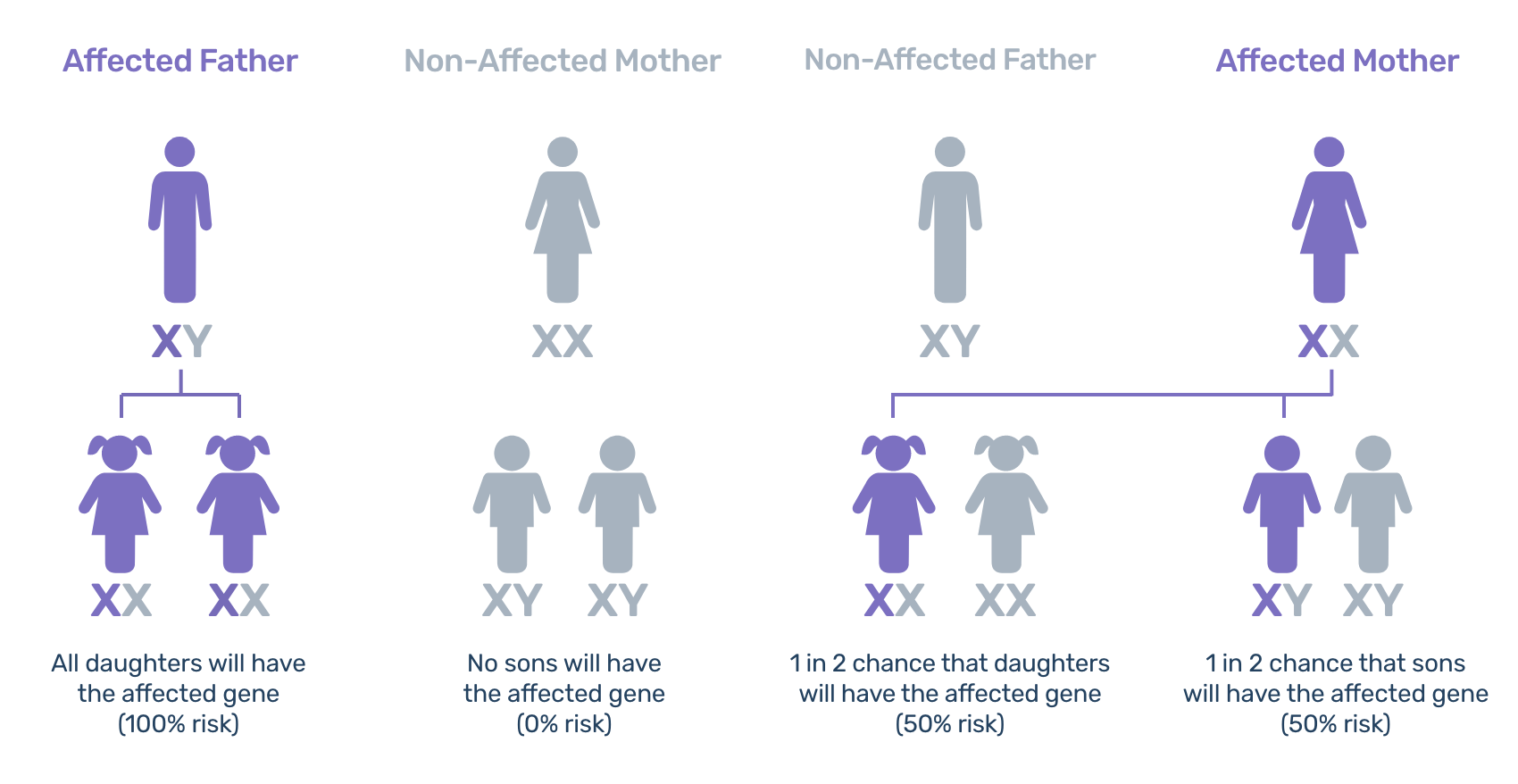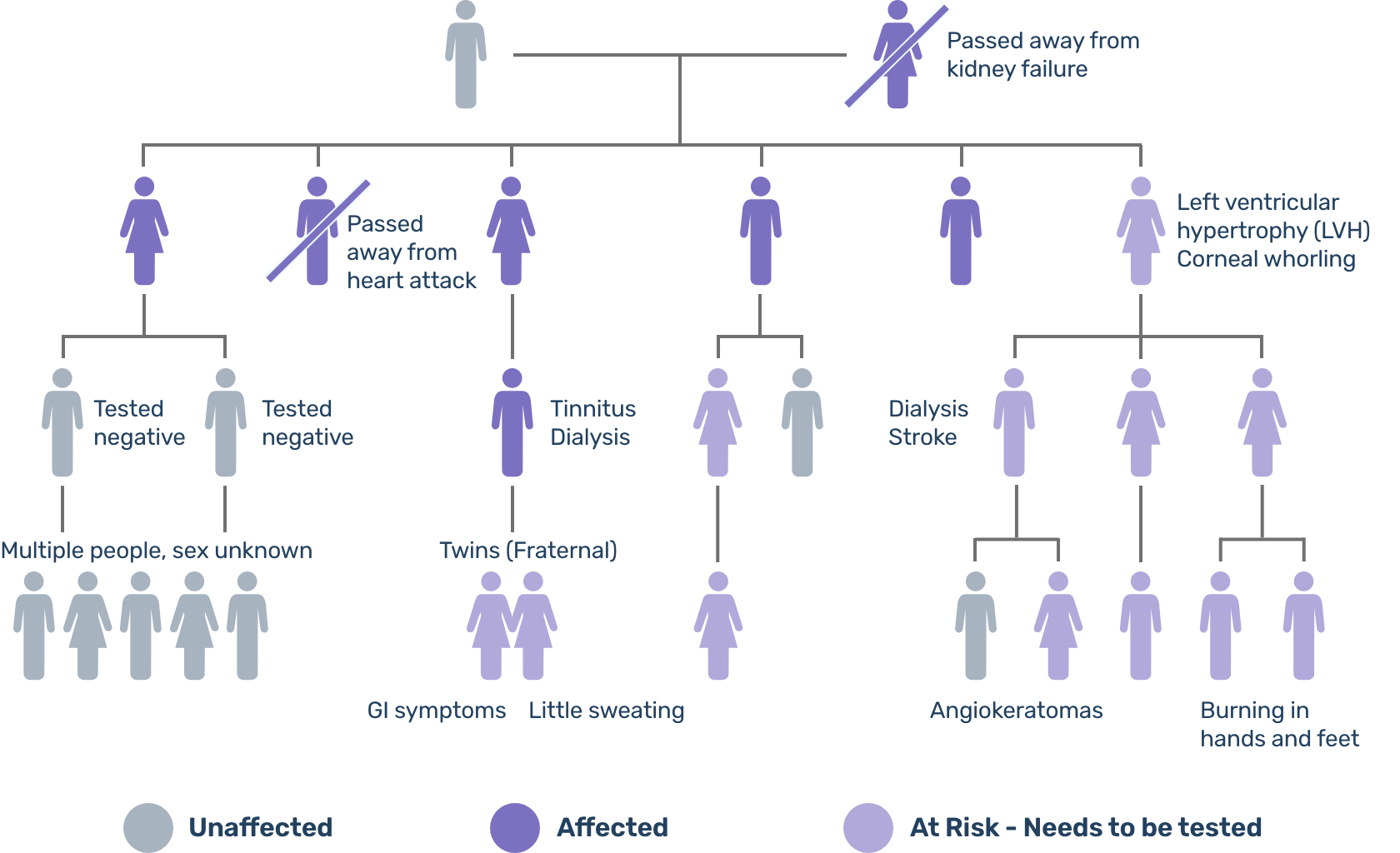FACING FABRY TOGETHER
Find out how Fabry disease affects families.
Life with Fabry disease: Then and now

“With our family, a lot of us had it, so we were able to share the ups and downs and the embarrassing aspects of the disease.”
Jodie, living with Fabry disease.
Navigating Fabry disease as a family
If one person in a family has Fabry disease, other family members (including siblings, children, parents, aunts, uncles, and cousins) may also have Fabry disease. On average, five other family members may be affected. This makes Fabry very much a family disease—not just immediate family, but extended family as well.
Discover resources for talking with your family about Fabry disease and help them find the information and support they need.
EXPAND THE FOLLOWING SECTIONS TO LEARN MORE.
-
Fabry is an X-linked disease, which means that the altered gene is located on the X chromosome.
 Chromosomes are the packaged genetic information used to make proteins that allow your body to work. Humans have 46 chromosomes. Two of them, called sex chromosomes, or X and Y chromosomes, determine whether a person will be male or female. Females have two X chromosomes, and males have an X and a Y chromosome. Females inherit an X chromosome from both their mother and father. Males inherit their X chromosome from their mother and their Y chromosome from their father.
Chromosomes are the packaged genetic information used to make proteins that allow your body to work. Humans have 46 chromosomes. Two of them, called sex chromosomes, or X and Y chromosomes, determine whether a person will be male or female. Females have two X chromosomes, and males have an X and a Y chromosome. Females inherit an X chromosome from both their mother and father. Males inherit their X chromosome from their mother and their Y chromosome from their father. The gene associated with Fabry disease is called GLA, and it is located on the X chromosome. The chance of inheriting the GLA alteration for Fabry disease depends on whether it came from the father or the mother. For each pregnancy, a female with Fabry disease has a 50% chance (1 in 2) of passing on the GLA alteration to her son or daughter.
The gene associated with Fabry disease is called GLA, and it is located on the X chromosome. The chance of inheriting the GLA alteration for Fabry disease depends on whether it came from the father or the mother. For each pregnancy, a female with Fabry disease has a 50% chance (1 in 2) of passing on the GLA alteration to her son or daughter.However, a father with Fabry disease will always pass on the GLA alteration to his daughter. On the other hand, the father will never pass on the GLA alteration to any of his sons, since sons always get their X chromosome from their mother.
-
The inheritance pattern is important because many patients living with Fabry disease endure many years of unmanaged symptoms and misdiagnoses. Tracing Fabry disease within a family accelerates the time to an accurate diagnosis.
Both males and females can be affected by Fabry disease as both sexes have at least one X chromosome.
This chart illustrates the inheritance pattern.

-
The first step in tracing Fabry disease in your family is creating a medical family tree. A medical family tree can help you understand the inheritance pattern in your family and the risk of passing on Fabry disease. A geneticist, genetic counselor, or CareConnectPSS Patient Education Liaison (PEL) can help you create a medical family tree and consider a family discussion.
Here is an example of a medical family tree:

A CareConnectPSS® Patient Education Liaison (PEL) can assist in creating a medical family tree.
Our Medical Family Tree: Exploring Your Roots worksheet can help you begin mapping your family history in preparation for your discussion.
-
If you have been diagnosed with Fabry disease, there are several important reasons why you may want to consider discussing it with your immediate and extended family:
- Fabry disease is inherited, so when one family member is diagnosed, others are likely to be affected
- A diagnosis can help family members understand previously unexplained symptoms
- The sooner family members at risk for Fabry disease are identified, the earlier they can explore disease management options
 Communicating with family members about a Fabry disease diagnosis can be challenging. We have created a sample letter to help you get started. You can use this sample letter to get suggestions for how to write your own message to your family members. Or you may simply email the letter we have provided.
Communicating with family members about a Fabry disease diagnosis can be challenging. We have created a sample letter to help you get started. You can use this sample letter to get suggestions for how to write your own message to your family members. Or you may simply email the letter we have provided.When and how to share your diagnosis is something you may wish to discuss with your treating physician or a CareConnectPSS Patient Education Liaison.
-
Testing enables earlier diagnosis and earlier access to appropriate care. A negative test result can relieve uncertainty, while a positive result can allow for informed health choices going forward.
A CareConnectPSS Patient Education Liaison (PEL) can help you map inheritance patterns, educate family members, and help you navigate other complex issues associated with Fabry disease.
-
 Finding out that a loved one has been diagnosed with a serious, rare medical condition is never easy. The more you know, the more confident you will feel about helping a family member with Fabry disease. This website is a good starting place to learn the basics about the disease.
Finding out that a loved one has been diagnosed with a serious, rare medical condition is never easy. The more you know, the more confident you will feel about helping a family member with Fabry disease. This website is a good starting place to learn the basics about the disease.When you are caring for someone with Fabry disease, it is important to take care of yourself both physically and mentally. Be sure to tap into CareConnectPSS, which offers free personalized and confidential support services for both patients with Fabry disease and those caring for them.



 Men have a 50% chance of inheriting Fabry disease from an affected mother, and will never inherit the gene from an affected father
Men have a 50% chance of inheriting Fabry disease from an affected mother, and will never inherit the gene from an affected father